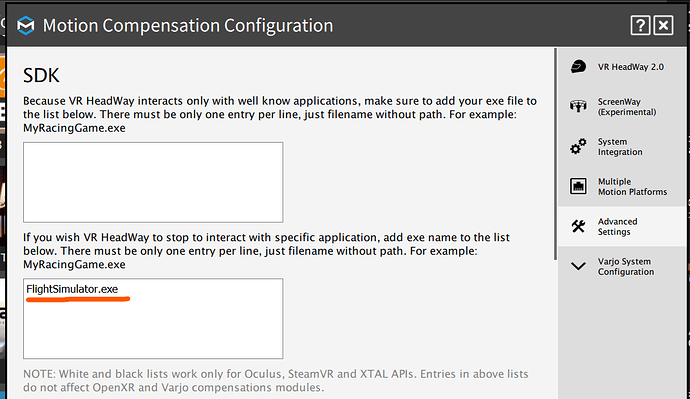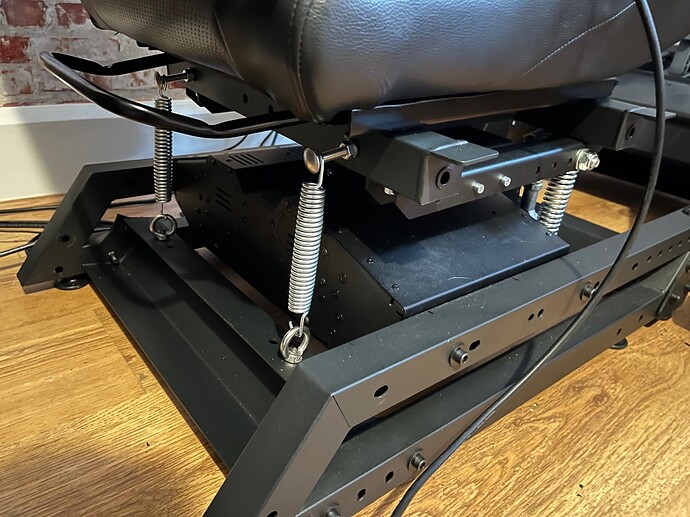After waiting a week, the only response I managed from NLR is ‘we’re looking into it and will get back to you’ so I decided to undertake a few experiments. The results are interesting, and at least for my use case fairly conclusive. This info will be particularly relevant for those like myself who are running the NLR Motion V3 with a GT Track cockpit, but could also be helpful for others depending on your setup so it’s worth documenting.
Id like to start by saying this was all just an experiment for my own curiosity and as soon as I have an official response and recommendations from NLR I’ll change my setup according to their guidance.
TLDR: The Gt Track Cockpit has balancing issues on the V3 when used in it’s recommended configuration.
Long Version: In an effort to troubleshoot my low speed stuttering, I decided to check the balancing by removing the front connecting rods and dampening springs. I also removed my shifter and handbrake (which are connected to the seat frame) so it was basically just me on the seat balancing on the V3’s central pivot.
My seat was about mid way on the sliders and it looked central but the seat instantly fell forward by a huge amount. I had to slide the seat all the way back until it hit the stops before it was even close to balanced. This however presented two huge problems. Firstly unless you have arms and legs like Mr Fantastic, the GT Track doesn’t have enough adjustment to bring the pedals and wheel close enough and secondly the GT Track has a design flaw that means if you slide the seat more than about halfway back the slider adjustment handle fouls on the supporting frame underneath the seat and doesn’t lock in position so the seat moves while you are driving/flying.
The first problem can be solved by moving the V3 forward to the next set of mounting holes in the cockpit frame (you have to leave out the middle set of bolts but they are not necessary anyway)
The second problem can be solved by first removing the seat from the frame. Then removing the slider mechanism from the seat and rotating it 180 degrees so the handle is at the back.
On reassembly, this configuration restricts access to the rear slider bolts so make sure to screw the slider to the frame on the rig first then bolt the seat to the slider. It’s all a bit fiddly but can be done easily enough with a bit of patience. To my surprise the slider is perfectly usable in this configuration and works well actually.
At this point my body is now back in it’s original position but the seat is much further back relative to the V3 pivot point.
I reconnected the front arms BUT NOT THE DAMPING SPRINGS and gave it a try. Voila, beautifully smooth motion in every direction! Unfortunately, the problem with not having the springs connected is that you get some lash in the system when it’s not moving (and I’m guessing the reason it has them in the first place)
So I reconnected the springs and unsurprisingly the jerky downward motion returned as this pulls down massively on the front unbalancing the unit again. At this point I have almost no more adjustment left on the rig so decided to try a counter balancing solution.
The result I came up with was to mount a set of 5.5" trampoline springs to the rear of the unit. I did this by using bolts in the exiting threaded holes on the seat frame and then inverting the rear brace on the GT Track and bolting some eyes through the pre-existing holes.
The result works really well and I now have smooth motion in all directions at any velocity. The side effect is that now the unit is re-balanced, a little bit of lash has returned but it’s only when the V3 is stationary or powered off and it’s worth the trade off IMO.
I’m still weighing up the pros and cons of running four springs vs no springs. having four seems to give a little more tolerance in terms of balancing but puts a little more load on the motors - but it’s a balanced load and the V3’s motors are easily up to it.
One other interesting point is that when I reconnected my shifter and handbrake (quite heavy lumps probably 10KG with the brackets and hardware) to the side of the chair (NLR’s recommended mounting) the stuttering returned so I now have them mounted to the frame of the rig which means they don’t move but i got used to that real quick and is a non issue for me. My HOTAS is fine and not heavy enough to cause issues.
So my takeaway from all this is that the V3 seems just as sensitive to balancing as any other motion rig and is effectively supplied ‘unbalanced’ due to the dampening springs at the front. Whether this poses an issue will depend on how it’s mounted and each use case. For all i know the motors are calibrated to compensate - but it certainly isn’t the case on my unit. Those using it exclusively for driving will likely never notice as the motion is typically fast enough to hide the problem anyway.
I’m highly surprised that NLR don’t mention balancing in the instructions and i wonder how many people use using unbalanced setups without knowing.
Here’s a pic of my don’t try this at home experimental solution for those who are interested:


